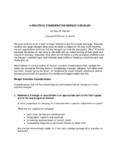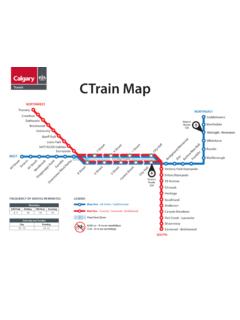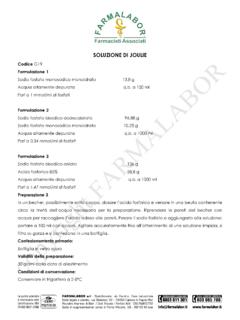Transcription of Oral Solutions Formulation of oral solutions - Ducopharm
1 1 oral Solutions oral liquids containing one or more active ingredients dissolved in a suitable vehicleFormulation of oral Solutions Check solubility of drug If decide to formulate as a solution will have to dissolve drug in the vehicle Ideal solvent is water Freely available, cheap, non-toxic Purified water BUT not all drugs are soluble in water Stability issues some drugs are not stable in aqueous solution pH dependent solubility and stabilityImproving aqueous solubility Cosolvency Ethanol, glycerol, propylene glycol, syrup pH control Weak acids, weak bases Consider pH-dependent stability Preservative activity Solubilization Complexation Chemical modificationDr. Tajber s PH1002 lecturesDr. Tajber sPH1002 & PH2002 lecturesFormulation Additives Buffers Carbonate, citrate, phosphate, lactate, gluconate, tartrate Colours Flavours, sweetening agents Preservatives AntioxidantsColours Soluble in water dyes (insoluble in water pigments) See list in Handbook of Pharmaceutical Excipients For extemporaneous preparation: amaranth solution 1 % v/vFlavouring agentsTaste of product Suitable masking flavour Salty Apricot, butterscotch, liquorice, peach, vanilla Bitter Anise, chocolate, mint, passion fruit, wild cherry Sweet Vanilla, fruits, berries Sour Citrus fruits, liquorice, raspberry 2 Flavours, sweetening agents [For extemporaneous dispensing].
2 Syrup (~20% v/v 60% v/v) Orange syrup (~10 - 20% v/v) Raspberry syrup (~10 - 20%v/v) Conc. raspberry juice (~ - 5% v/v) Concentrated peppermint emulsion (~ v/v) Sorbitol ( oral solns.:20-35% w/v; oral susps.: 70% w/v) Saccharin ( w/v) Sodium cyclamate ( w/v) Anise water ( v/v) Conc. camphor water (1% v/v) Liquorice liquid extract (5% v/v) Glycerol (up to 20% in alcoholic elixirs)Preservatives Chemical agents that prevent growth of microorganisms in the product, thereby rendering it safe in use and increasing its shelf life. Microorganisms may cause several problems as, , undesired visible growth or chemical changes of the product. Contamination by microorganisms may also be associated with health hazards. Preservatives are typically used in liquid products that do not have extreme pH values or a high concentration of surfactants.
3 , products with a pH between 3 and 10 generally require preservative(s) to avoid growth. Preservatives contd. Chloroform water Double strength Single strength Chloroform spirit Appropriate volumes should be used such that final concentration of chloroform in the preparation is v/vChloroform water, chloroform spirit Chloroform spirit Chloroform 50ml Ethanol (90%) to 1000ml Chloroform water Chloroform Water to 1000ml Double strength chloroform water Chloroform 5ml Water to 1000mlConcentrated chloroform water 10% v/v chloroform, 20 x conc. of double strength chloroform water[1998] Peppermint water for 4 day old infant with colic, ml peppermint emulsion + 75 ml DSCW make up to 150 ml with waterPreservatives contd. Ethanol 10% v/v Benzyl alcohol v/v ( don t use in newborns fatal adverse reactions).
4 Optimum activity at pH less than 5 Glycerol (Glycerin)>20% w/v Propylene glycol15-30% w/vPrimarily used as solventUsed as sweetening agent in alcoholic elixirs (up to 20%)Also used as solvent/co-solvent2. Paediatric Paracetamol oral Solution 25 mlLabel Paediatric Paracetamol oral Solution is a solution containing w/v of Paracetamol in a suitable flavoured vehicle. Paediatric Paracetamol oral Solution should not be 1: solubility of paracetamol? Martindale : Sparingly soluble in water; freely soluble in alcohol; very slightly soluble in dichloromethane. Sparingly soluble: 1 in 30 to 1 in 100 w/v = g in 100 ml or g in 25 ml To dissolve g need ~60ml water!! Freely soluble: 1 in 1 to 1 in 10 To dissolve g need ~6 ml alcohol (24% v/v) Use alcohol as co-solvent Pharmaceutical Codex: Soluble, at 20o, in 70 parts of water, in 7 parts of alcohol, in 13 parts of acetone, in 40 parts of glycerol and in 9 parts of propylene Could use propylene glycol as co-solvent To dissolve g need ml propylene glycolEthanol in liquid preparations intended for children American Academy of Pediatrics Pediatrics Vol 73 No.
5 3, a 6 year old would need to ingest 40 ml of 10% ethanol every 4 hours to maintain a BEC of 25mg/100 mlBlood ethanol concentration (BEC) that shouldn t be exceed = 25 mg/100 mlRecommendations Over the counter (OTC) liquid preparations should be limited to a maximum of 5% v/v ethanol Physician supervision is suggested for children less than 6 years using OTC preparations containing alcohol The amount of ethanol contained in any medicinal preparation should not be able to produce a blood concentration greater than 25 mg/100 ml after a single recommended dose and appropriate intervals between doses to prevent accumulationIPHA Medicines Compendium Dozol syrup 120mg/5ml paracetamol = w/v Macrogol 4000 co-solvent Glycerol co-solvent Propylene glycol co-solvent Liquid sorbitol 70% sweetener Liquid maltitol sweetener Sodium cyclamate sweetener Nipaseptpreservative Annatto extract (E160)colouring agent Ponceau 4R (E124)
6 Colouring agent Caramel flavourfavouring agent Purified waterIPHA Medicines Compendium Paralink Paracetamol Solution 120mg/5ml paracetamol = w/v Polyethylene glycol 4000 co-solvent (Macrogol 4000) Glycerolco-solvent Propylene glycolco-solvent Ethanol (absolute alcohol)co-solvent Liquid sorbitol 70%sweetener Liquid maltitolsweetener Sodium cyclamatesweetener Nipaseptpreservative Raspberry superbeflavouring agent Purified water4 Your Formulation ??Paracetamol24 gColouring agent ( Amaranth solution) ( benzoic acid, chloroform - from chloroform spirit, single or double strength chloroform water) agent/sweetening (s) to 1000 ml1 Preservatives contd. Ethanol 10% v/v Benzyl alcohol v/v ( don t use in newborns fatal adverse reactions). Optimum activity at pH less than 5 Glycerol (Glycerin)>20% w/v Propylene glycol15-30% w/vPrimarily used as solventUsed as sweetening agent in alcoholic elixirs (up to 20%)Also used as solvent/co-solventPreservatives contd.
7 Benzoic acid oral solns & susps: - w/vSlightly soluble in water, freely soluble in EtOHGreatest activity at pH 5 Benzoic acid solution Sodium benzoateFreely soluble in water, sparingly soluble in - w/v Sorbic w/vNo antibacterial activity at pH >6 Potassium - w/vBenzoic acid 50 gPropylene glycol 750 mlWater to 1000 mlPreservatives contd. Parabens (Hydroxybenzoate) Esters of 4-hydroxybenzoic acid, only differing in the ester group Butlyparaben w/v for oral solns. and susps. w/v for oral solns. and susps. w/v for oral solns. and susps. w/v for oral solns. and susps. As a group effective over wide pH range (4-8) and have broad antimicrobial activity Often used in combination activity may be improved additive effects ( Nipasept) Poor solubility often used as sodium saltAntioxidants Ascorbic acid and sodium - w/v Sodium - w/vTypes of oral Solutions Mixtures are oral liquids, usually aqueous preparations, containing one or more active ingredients dissolved orsuspended in a suitable of oral Solutions contd.
8 Elixirs are clear, flavoured oral liquids containing one or more active ingredients dissolved in a vehicle that usually contains a high proportion of Sucrose or a suitable polyhydric alcohol or alcohols and may also contain Ethanol (96 per cent) or a Dilute Ethanol. Polyhydric alcohol: alcohols containing >1 hydroxyl group glycols propylene glycol CH3CH(OH)CH2OH; polyethylene glycols (PEGS, macrogols) OHCH2(CH2CH2O)nCH2OH; glycerol CH2 OHCHOHCH2 OHTypes of oral Solutions contd. Linctusesare viscous oral liquids that may contain one or more active ingredients in solution. The vehicle usually contains a high proportion of Sucrose, other sugars or a suitable polyhydric alcohol or alcohols. Linctuses are intended for use in the treatment or relief of cough, and are sipped and swallowed slowly without the addition of waterOral Suspensions oral Suspensions are oral Liquids containing one or more active ingredients suspended in a suitable vehicle.
9 Suspended solids may slowly separate on standing but are easily of formulating products as oral suspensions Suspended insoluble powders easier to swallow than tablets/capsules Uniform dispersal of disperse phase for more effective absorption after dosing Good for bulky insoluble powders Kaolin Insoluble derivative may be more palatable than soluble equivalent Insoluble derivative may be more stable in suspension than equivalent soluble salt Superior chemical stability of dispersed drugs in comparison to Solutions If a drug is not very soluble can formulate as a suspension a dispersion of finely divided insoluble solid particles (the disperse phase) in a fluid (the dispersion medium) The suspension must remain sufficiently homogeneous for at least a period between shaking the container and removing the required dose The sediment produced on storage must be easily resuspended by the use of moderate agitationStokes law : velocity of fall (rate of sedimentation) g: acceleration due to gravity s: density of sphere f : density of liquid d: diameter of sphere : viscosity of liquid() 182gdfs =3 Ways of reducing rate of sedimentation Reduce particle size Particle size may change on storage particularly if there is temperature fluctuation: solubility may increase as temp.
10 Increases, on cooling drug will crystallise out. Reduce density difference between particle and liquid Increase liquid density Add sucrose, sorbitol, glucose, glycerol or other soluble, non-toxic materials density modifiers (may also be viscosity modifiers) Increase liquid viscosity Add a thickening or suspending agent1 Diffusible and indiffusible solids Diffusible solid does not dissolve in the vehicle but may be mixed with vehicle so that, upon shaking, the powder is evenly diffused throughout the liquid for sufficient time to ensure uniform distribution in each dose. light kaolin, light magnesium carbonate (in Kaolin Mixture ) Indiffusible solid a solid is regarded as indiffusiblewhen it does not remain evenly distributed in the vehicle long enough to ensure uniformity of the measured dose the vehicle must therefore must be increased in viscosity use a suspending agent Kaolin Mixture Extemporaneous preparationThe following formula applies.







